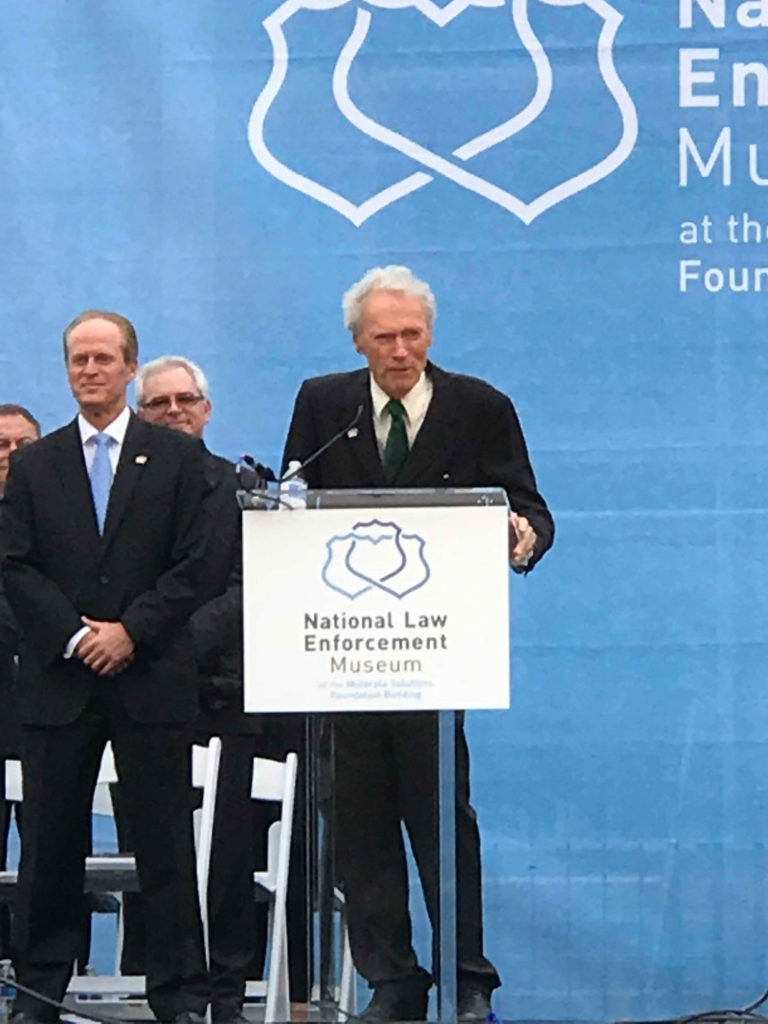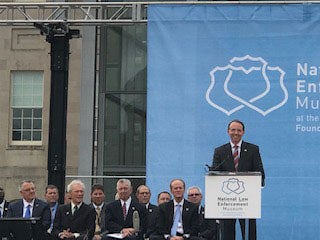A public block party and a “Run for the Badge” 5K race Saturday will mark the opening of Washington’s newest museum: the National Law Enforcement Museum.
Eighteen years in the making, this splendid underground facility sits in Judiciary Square just across the street from the National Law Enforcement Officers Memorial, itself a majestic site containing the names of more than 21,000 officers killed in the line of duty throughout our nation’s history.
I had the good fortune Thursday to attend a ribbon-cutting ceremony and to tour the new museum.
Speakers included Interior Secretary Ryan Zinke, former Attorney General John Ashcroft, Deputy Attorney General Rod Rosenstein, D.C. Mayor Muriel Bowser, former D.C. and Philadelphia police chief Charles Ramsey, and “Dirty Harry” himself—celebrated actor and director Clint Eastwood, honorary chairman for the National Law Enforcement Officers Memorial and Museum.
Former Attorney General John Ashcroft addresses guests. (Photo: John G. Malcolm for The Daily Signal)
The opening of the museum comes at a pivotal moment for law enforcement in this country. Two years ago, I wrote about the rising tide of antagonism against the men and women who serve our communities and put their lives on the line every day to keep us safe. They rush toward danger. Some of them do not return.
Last year, 129 law enforcement officers made the ultimate sacrifice, and, sadly, in 2018, officer fatalities are up 5 percent to date. Some of these officers were the victims of ambushes, premeditated attacks intended to harm those who enforce the law.
In 2016 (the last year for which data is available), nearly 58,627 officers were assaulted and 16,667 of them suffered serious injuries.
Hardly a week goes by without a headline about an officer being injured or killed. Just last week, seven officers were shot in South Carolina, one fatally. The week before that, two officers were fatally shot in Mississippi.
The museum provides visitors the opportunity to discover the stories of famous lawmen, learn in the Hall of Remembrance about those who gave their lives protecting others, and see mementos left at the wall of the memorial across the street by former colleagues and loved ones to honor them.
Hollywood icon Clint Eastwood, who has portrayed lots of cops, speaks during the opening ceremony. To his right is Craig Floyd, CEO of the National Law Enforcement Officers Memorial Fund. (Photo: John G. Malcolm for The Daily Signal)
The exhibits at the museum also will help people learn how law enforcement techniques have evolved and about the many ways that law enforcement officials serve and protect communities on a day-to-day basis.
Among the exhibits are Eagle One, the U.S. Park Police helicopter used to rescue six passengers after an Air Florida passenger flight out of National Airport struck the 14th Street Bridge and plunged into the Potomac River on a frigid night in January 1982.
Also on view are artifacts such as evidence from the investigation of the “D.C. sniper” as well as the credentials of Eliot Ness, the prohibition agent who led the “Untouchables” against Al Capone and the Chicago mob. Capone’s bulletproof vest is there too.
The museum “is dedicated to telling the story of American law enforcement by providing visitors a ‘walk in the shoes’ experience.”
It accomplishes this, and quite admirably too, through immersive exhibits and hands-on learning that enable visitors to experience for themselves the many facets of modern law enforcement, from call centers to forensics to walking the beat to engaging in “shoot or don’t shoot” training exercises.
On the lighter side is a “Reel to Real” exhibit showing how law enforcement officers have been depicted over the years on radio and TV shows and in the movies.
Deputy Attorney General Rod Rosenstein takes the microphone. (Photo by John G. Malcolm for The Daily Signal)
Including educational programs and outreach, the museum aims to build bridges between law enforcement officers and the communities they serve. By working with adults and children, and by providing real contact with law enforcement officials, this museum can build greater empathy and understanding—and ultimately trust, mutual respect, and cooperation.
And not a moment too soon.
The museum is the brainchild of Craig Floyd, CEO of the National Law Enforcement Officers Memorial Fund, and his mentor, Mario Biaggi, the former Democratic congressman from New York City, a former highly decorated police officer who was injured 11 times in the line of duty.
This valuable institution will serve as a memorial to fallen officers, a tool to educate the public about the rigors and realities of modern law enforcement, a vehicle for bridging the divide that exists in many communities between peace officers and those they serve, and a place for ongoing dialogue about tough issues that will help define the future of policing.
So, if you are in town or planning to visit, the National Law Enforcement Museum is a crown jewel that deserves to be seen and experienced.
Visitors will learn about courage, honor, and sacrifice. And the museum is a tremendous asset that undoubtedly will do a lot of good for the country in the years to come.
This piece originally appeared in The Daily Signal








